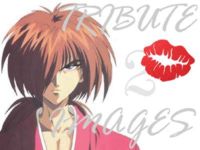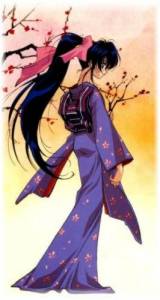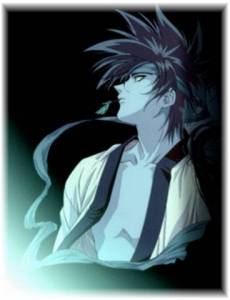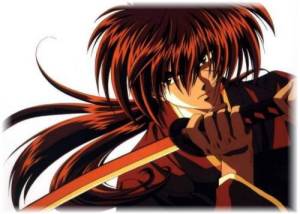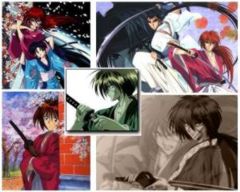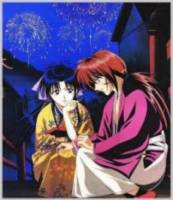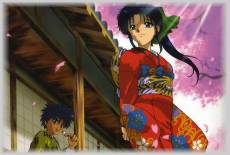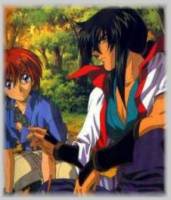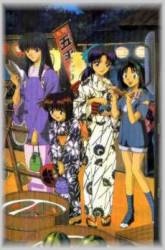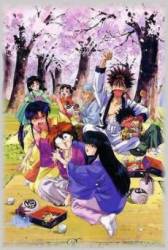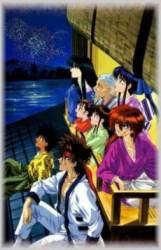|
SHRINE
X |
BEST ANIME SCENES HUMOR OR SO PERSONAL ANIMANIA
|
RUROUNI KENSHIN
a.k.a
KENSHIN THE WANDERER a.k.a
SAMURAI X
Title:
Rurouni Kenshin: Meiji Kenkaku Romantan
(Kenshin the Wanderer: Romance of the Meiji Era) Formats: comic books, TV series, video exclusives, movies. Rating: they assume that a 13 year-old could somehow digest everything dished out here, as long as his parents never stop explaining whatever happens to be onscreen. Which, of course, would make no 13 year-old watch the anime at all. Treshold of gore: mostly insignificant cuts & bruises, though death-rate keeps up with other action movies. Sexual content: sort of even less than existing. Degree of depression & nervous breakdown: unbearably ridiculous in some episodes, i.e. when Himura was to face his ex brother in-law, and when Kamiya was left by Himura after Okubo got assassinated. Ingredients: historical setting (Japanese Meiji era, end of 1800's & dawn of 1900's), martial arts swordsplay, kendo, kenpo, kungfu), bombs, identity politics, political contests, philosophy of power, social dissilusionment, psychological transformation, maladjustment, and so forth, you know the stuff. Latest news when this is written: total overhaul of everybody's looks & lives in a video movie I don't like, 2002.
Upside: 1. Nobody ever took this part of the history of Japan into the realm of pop culture the way Watsuki Nobuhiro did. All tomes and flicks around the same area have been warped through the perspective of the Tokugawa shogunate; none took the Meijian view of the stuff -- except those products woven around Sakamoto Ryoma. 2. The soundtrax are listenables among the hordes of heartbreaking & earinsulting anime theme songs. Check out for instance Heart of Sword by T.M. Revolution, and It's Gonna Rain by Bonnie Pink & Tore Johannson.
Downside: 1. In the original Japanese anime, the voice casts are superb except Kenshin Himura's. 2. Watsuki caused an incurable revival of the Shinsengumi fandom all over the world since this tome was put among the Japanese export cargo in late 1990's.
This shameless tribute is basically upon the original manga & first flock of TV series. First
anime release © 1996 Studio Gallop, Studio Deen, Fuji
TV. The anime is based on Watsuki Nobuhiro's manga, published by Kodansha Ltd., Tokyo, Japan, 1994.
Reality check: Watsuki's manga was based on real-life historical personalities, especially the Kyotoite assassin Kawakami Gensai, Satsumanese streetfighter Sano Takenosuke, the Shinsengumi'd captain of patrolmen Saito Hajime, and Minister of the Interior Okubo Toshimichi. Sano Takenosuke was the man who actually triggered what we now know as the Meiji versus Tokugawa War, AKA the real civil war of Japan (I never call the 16th century wars such). Click any of those names in blue above and you'd know why and when and how.
NOTE:
Deviating from my habit, when it comes to this series' characters I
tend to lapse into the Northern way of saying names -- |
FOR REAL-LIFE
PERSONS
WHOSE BIOS INSPIRED WATSUKI TO CREATE THESE CHARACTERS
![]()
CLICK
HERE
| VISUAL WANDERER |
|
Kaoru Kamiya
|
All Watsuki's characters in Rurouni Kenshin, in fact, are blessed with the wonderful potion of studied simplicity and a relentless eye for complication. Kaoru and the rest of the cast in the original manga has a Watsukian trait, i.e. they look like they are, at the same time they look unlike so. Kaoru is always in the intricate kimono that says nothing but feminine charm; her mental makeup fits into the kimono too; and the denizen of her head defy all those, and she fights her literal fights as badly as she cooks, and she gets away with all of the above, because Watsuki has a way to paint the entire portrait of her without any contradictory element popping up. Just how, beats me. That's why I love him.
|
|||
|
Sanosuke Sagara Sanosuke Sagara is my favorite among Watsuki Nobuhiro's characters in this tale of the churning Meiji era, even as he never pays for anything he eats. He is probably based on the real-life streetfighter of the Meiji era (click here if you have no idea what I'm talking about), the Satsuma warrior Sano Takenosuke. Made to wear some outfit that run our imagination over [check out the footnote], the basically bad-tempered and loyally helpful ken-po master, careless and thoughtful, good-looking and unsightly man is, however, a former opponent of the leading character Kenshin Himura and his steady ally since getting fairly defeated in a duel -- I guess Watsuki just couldn't find any other excuse to team them up, that this stale blue line of any such story is in use at all. The paradoxical traits in just any human is explored and visually asserted in Sanosuke as well as other Watsukinian people without any major desertion from commonsense, even though sometimes the fact that this was studied shows. Nevertheless Sanosuke is a visual triumph.
FOOTNOTE Like, who would have thought of such a sense of fashion? Watsuki really excels in this, as you could see that all characters don't have anything resembling each other's on, and he is a genius, I think, in creating Makoto Shishio -- Kenshin's first arch-enemy -- who wears nothing but bandages, being told of as wholly burnt alive a few years earlier in his criminal career. Sanosuke wears a fluttering red bandanna; a white something that echoes the common ken-po artists' obligatory uniform in official competitions, but the top is left untied; his footwear is a pair of 'kung-fu shoes' like Jackie Chan's; and white cloth bandages cover his hands, feet and belly as some form of protective gear in fights. The peculiar place and time that make the room for Watsuki's story to roam present much difficulty for visualization of characters, but at the same time provide countless possibilities, too -- among his characters, Kenshin's rival and temporary ally Hajime Saito looks like Japan in the new dawn of the Meiji period: sleek, slim, neat, precise, and/or other such adjectives that might be thinkable, in his blue police uniform. Antagonists are depicted in a dazzling variety: Jine Udo is like a wandering ronin, ninja undercover or dubious monk with the large conehat and walking stick, Kamatari the transgendered wears a female kimono with a fat cord, Iwanbo reminds us of an almost naked sumo wrestler; just to give a few examples. The era is the moment of foreign influences after the hundreds of years of Tokugawa shogunate's 'clamming up' policy. Watsuki seizes this mental folder's contents and produces his own brand of East-and-West 'cross-dressing', such as the perfect timeless coat worn by Aoshi Shinomori (Kenshin's rival; they are even in swordsmanship) and the super-macho-but-flamboyant cloak that gives Seijuro Hiko (Kenshin's teacher) the desired look of fantastic out-of-this-world superheroic impression.
|
||||
|
Kenshin Himura Drawing a character as richly complicated as Kenshin Himura is never a piece of cake. Kenshin is based on an actual historical figure, a Kawakami Gensai, professional assassin who worked for and in the end destroyed by the Meiji Restoration; itself an intricate business of political, economic, social and cultural revolution of the country we know today as Japan. (Click here for real-life assasins in that era, stories, and pictures.) Bound by a specific historical period (early 1900's) and sites (Tokyo and Kyoto, both symbolizing the traditional and modern Japan respectively), Kenshin wears kimono but it is colored violet, his feet are protected by socks and sandals but his hair is red and long, he is sword-toting everywhere but he does all sorts of household chores, including cooking and laundring and scrubbing the floors. Within this one character the old and the new Japan melt. That is a great achievement; Watsuki's. Like the real Kawakami, Himura is forever youthful and he also started out splitting people into halves for a living since the age when today's boys got nothing on their minds but pimples and digital games and occasional wet dreams. This haunting past, the present contradictory wishes, and a future where anything could happen, must show in Kenshin Himura's visualization. That, I suspect, is the reason why Watsuki gives him the famous 'X' scar on his cheek, thereby tarnishing the otherwise typical beauty anime men tend to be endowed with. But the overall characteristic Kenshin is made to impart is that of the ideal Japanese men of golden days; one who follows the bushido with a personal tint in it, one so man that today's 'salarymen' of Tokyo look like worthless, faceless, meaninglessly fussy caricatures. Kenshin is calm and under control in most situations -- the only exception is whenever Watsuki wants him to insert a visual 'pagebreak', i.e. in short domestic comical interludes. He adjusts the drawing accordingly. Usually reviewers and hosts of the gullible hordes of fans compare Kenshin with other anime swordsmen, like 1. the barefooted, dull-light-blue-haired elfin Inuyasha [Inuyasha], 2. the mad-eyed, possessed, spiky-haired Kyo or Kyoshiro [Samurai Deeper Kyo], 3. the futuristic, brooding, daredevil Orphen [Sorcerous Stabber Orphen], and 4. the habitually silent, thoughtful, perfectly composed Yagyu Jubei [Ninja Scroll].
I think Kenshin isn't like them all except Jubei -- the name and personality comes from an actual man of the famous Yagyu clan (early 17th-century), historically less reknown than his older brother Matajuro and inimitable father Mataemon, but probably most people outside Japan only knows Jubei thanks to the critically acclaimed movies. The others, even the slightly 'historical' Kyo -- its climax consists of a battle against the resurrection of (oh yeah, I hate this) Oda Nobunaga, belong to the usual genre of slash-slash-slash within which science-fiction mostly reigns. The original Rurouni Kenshin manga is rather 'dark', something that doubtlessly was also felt by the Marketing Dept. persons when it was animated, and they tried to brighten it up with irrelevant episodes which actually enhanced the 'dark' atmosphere because viewers recognize them as having nothing to do with the main story. However, Watsuki's Meiji is a generally optimistic Meiji; Kenshin is not Kawakami.
Inuyasha © 2000 Nippon TV, Sunrise, Yomiuri TV. Script by Ikeda Masashi, Yamada Takashi & Sumizawa Katsuyuki, designer Suganuma Eiji, animators Soeta Kazuhiro, Suganuma Eiji & Sakuma Shinichi, music by Wada Kaoru, director Ikeda Masashi & Nishimori Akira. Sorcerous Stabber Orphen © 1998 J.C. Staff, TBS, script by Sekijima Mayori, Kubota Masashi, Yamada Yasushi, Araki Kenichi & Kanemaki Kenichi, designer Aizawa Masahiro, animator Aizawa Masahiro, music by Hatake & Sharan, directors Watanabe Hiroshi & Suzuki Akira. Ninja Scroll © Madhouse, Toho, Movic. Script by kawajiri Yoshiaki, designer Minowa Yutaka, animator Minowa Yutaka, music by Wada Kaoru, director Kawajiri Yoshiaki.
|
||||
| X FAMILY VALUES |
|
Fireflies
|
Home
|
Lesson
|
|
Shopping |
Picnic |
Fireworks |
| X PARODIES | |||
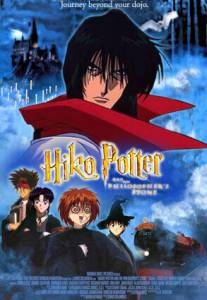 |
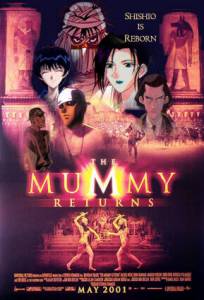 |
||
| Seijuro Hiko, Kenshin's teacher, is a potter. He makes terracotta objects when not teaching martial arts. | 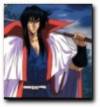 THE 'REAL' HIKO |
Makoto Shishio is someone who was supposed to be dead when burnt all over, but he survived, wearing bandages around every inch of his body because of the massive disfigurement. | 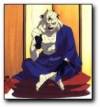 THE 'REAL' SHISHIO |
|
|
